tow CHEVROLET TRACKER 1998 1.G Owners Manual
[x] Cancel search | Manufacturer: CHEVROLET, Model Year: 1998, Model line: TRACKER, Model: CHEVROLET TRACKER 1998 1.GPages: 386, PDF Size: 21.17 MB
Page 14 of 386
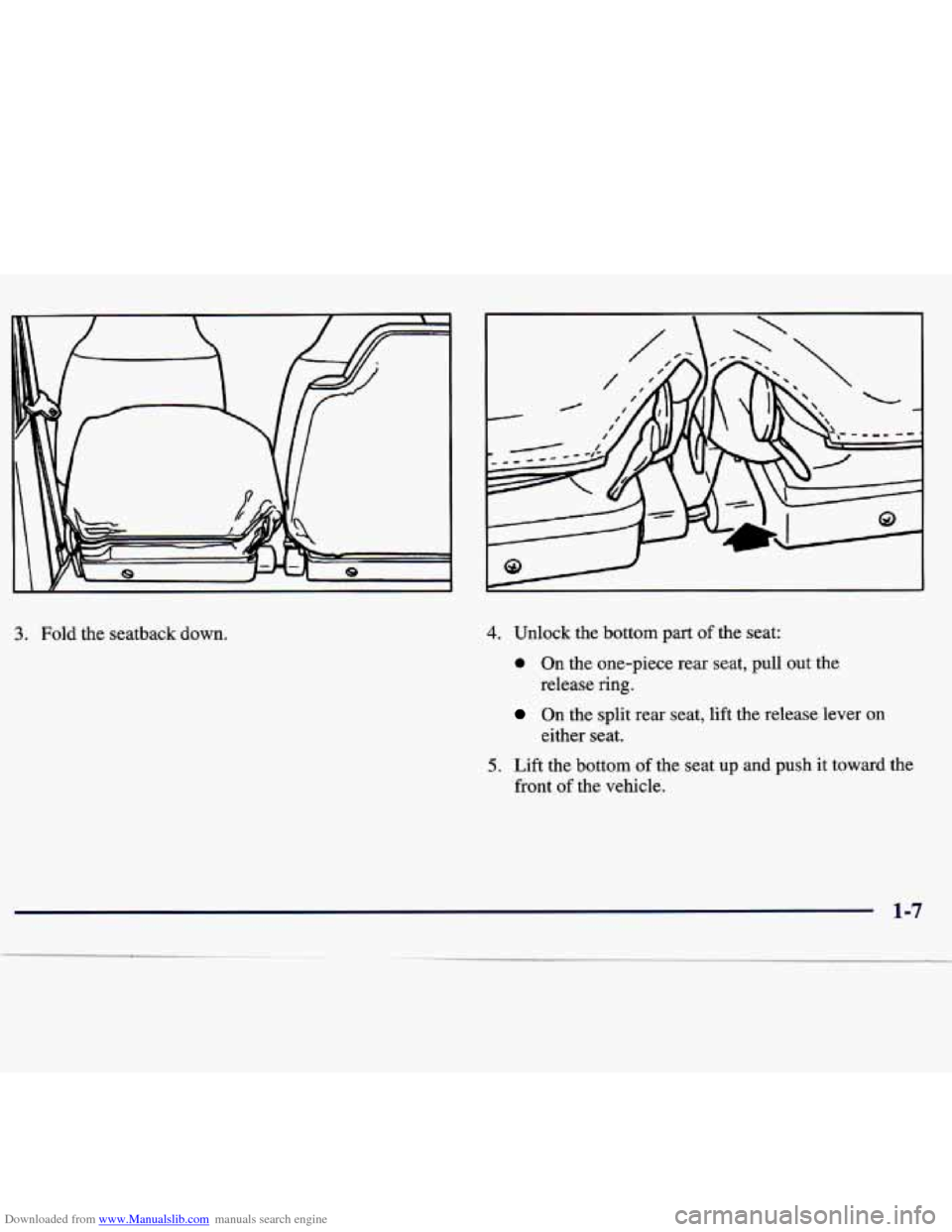
Downloaded from www.Manualslib.com manuals search engine 3. Fold the seatback down. 4.
5.
Unlock the bottom part of the seat:
0 On the one-piece rear seat, pull out the
On the split rear seat, lift the release lever on
release ring.
either seat.
Lift the bottom
of the seat up and push it toward the
front
of the vehicle.
1-7
Page 16 of 386
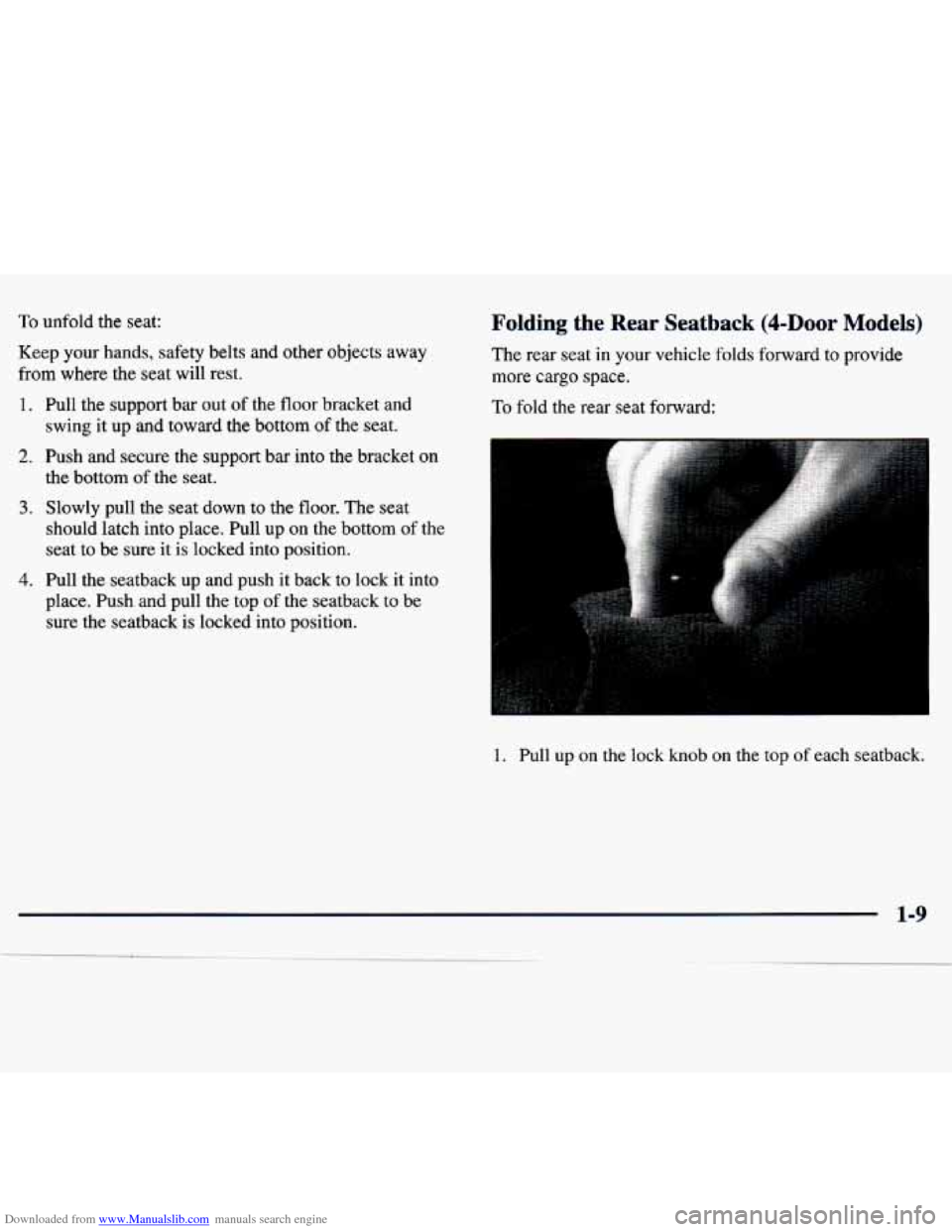
Downloaded from www.Manualslib.com manuals search engine To unfold the seat:
Keep your hands, safety belts and other objects away
from where the seat will rest.
1. Pull the support bar out of the floor bracket and
swing it up and toward the bottom
of the seat.
2. Push and secure the support bar into the bracket on
the bottom
of the seat.
Folding the Rear Seatback (4-h~ Models)
The rear seat in your vehicle folds forward to provide
more
cargo space.
To fold the rear seat forward:
3. Slowly pull the seat down to the floor; The seat
should latch into place. Pull up on the bottom
of the
seat to be sure it is locked into position.
4. Pull the seatback up and push it back to lock it into
place. Push and pull the top
of the seatback to be
sure the seatback is locked into position.
1. Pull up on the lock knob on the top of each seatback.
1-9
Page 18 of 386
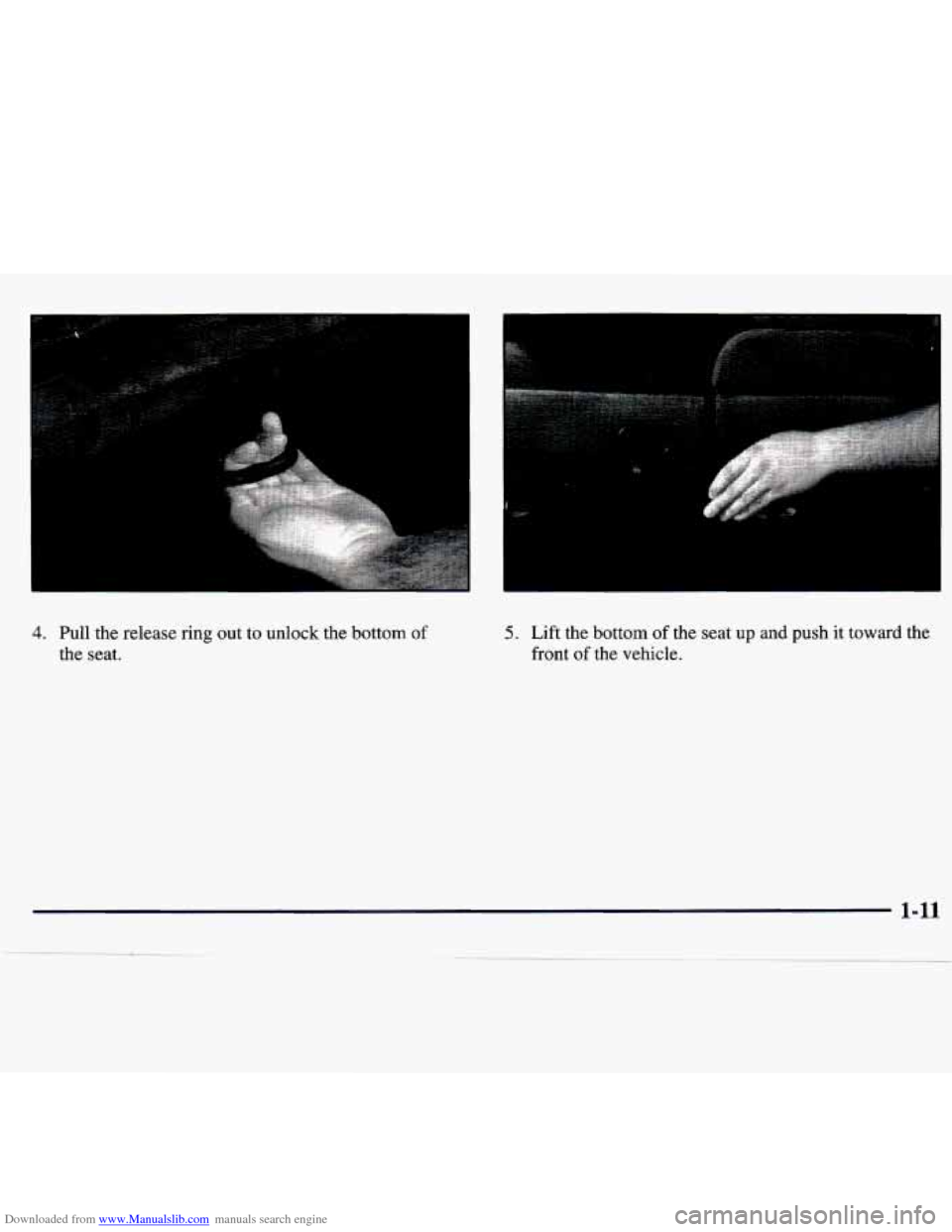
Downloaded from www.Manualslib.com manuals search engine 4. Pull the release ring out to unlock the bottom of
the seat.
5. Lift the bottom of the
front of the vehicle.
-
seat up and push it toward the
1-11
Page 36 of 386
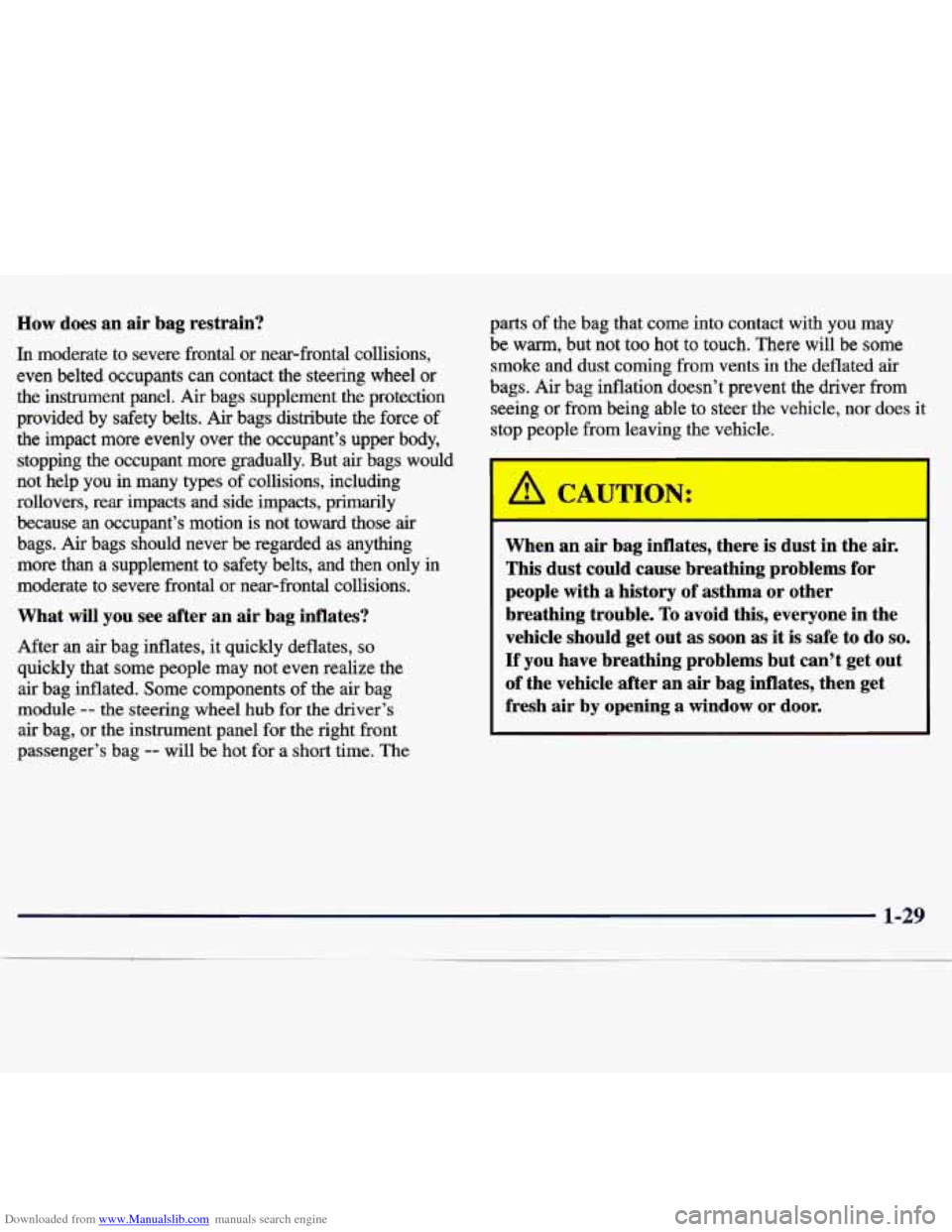
Downloaded from www.Manualslib.com manuals search engine How does an air bag restrain?
In moderate to severe frontal or near-frontal collisions,
even belted occupants can contact the steering wheel or
the instrument panel.
Air bags supplement the protection
provided by safety belts.
Air bags distribute the force of
the impact more evenly over the occupant’s upper body, stopping the occupant more gradually. But air bags would
not help you in many types of collisions, including
rollovers, rear impacts and
side impacts, primarily
because an occupant’s motion
is not toward those air
bags. Air bags should never be regarded as anything more than a supplement to safety belts, and then only in
moderate to severe frontal or near-frontal collisions.
What will you see after an air bag inflates?
After an air bag inflates, it quickly deflates, so
quickly that some people may not even realize the
air bag inflated. Some components
of the air bag
module
-- the steering wheel hub for the driver’s
air bag,
or the instrument panel for the right front
passenger’s bag
-- will be hot for a short time. The parts
of the bag that come into contact with you may
be
warm, but not too hot to touch. There will be some
smoke and dust coming from vents in the deflated air
bags. Air bag inflation doesn’t prevent the driver from
seeing or from being able to steer the vehicle, nor does it
stop people from leaving the vehicle.
’ A CAUT IN: rn
When an air bag inflates, there is dust in the air.
This dust could cause breathing problems for
people with
a history of asthma or other
breathing trouble. To avoid this, everyone in the
vehicle should get out
as soon as it is safe to do so.
If you have breathing problems but can’t get out
of the vehicle after an air bag inflates, then get
fresh air
by opening a window or door.
1-29
Page 37 of 386
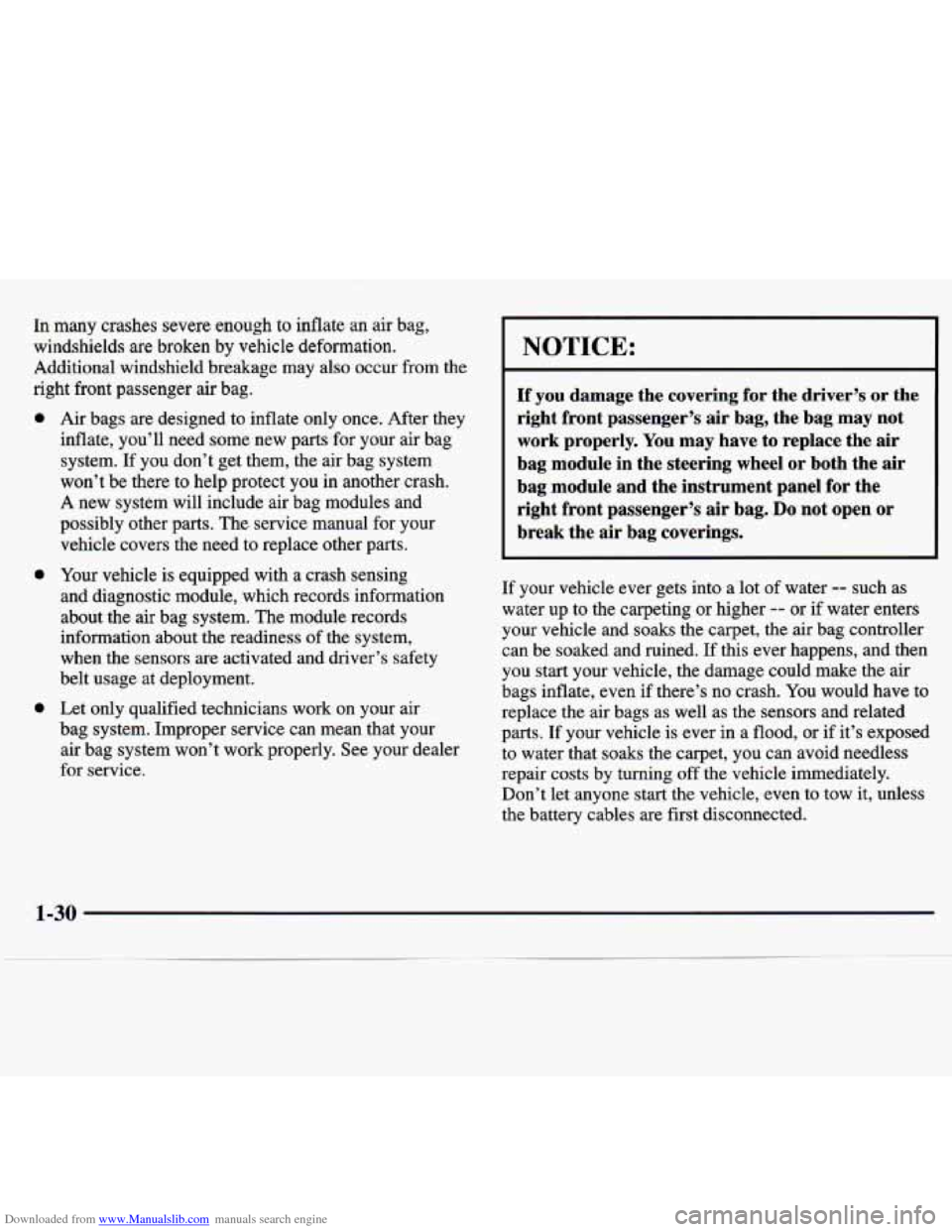
Downloaded from www.Manualslib.com manuals search engine In many crashes severe enough to inflate an air bag,
windshields
are broken by vehicle deformation.
Additional windshield breakage may also occur from the
right front passenger air bag.
e
0
e
Air bags are designed to inflate only once. After they
inflate, you’ll need some new
parts for your air bag
system. If you don’t get them, the air bag system
won’t be there to help protect you in another crash.
A
new system will include air bag modules and
possibly other parts. The service manual for your
vehicle covers the need to reglace other parts.
Your vehicle is equipped wityi a,t-fslsh sensing
and diagnostic module, which records information
about the air bag system. The module records
information about the readiness of the system,
when the sensors
are activated and driver’s safety
belt usage at deployment.
Let only qualified technicians work on your air
bag system. Improper service can mean that your
air bag system won’t work properly. See your dealer
for service.
NOTICE:
If you damage the covering for the driver’s or the
right front passenger’s air bag, the bag may not work properly.
You may have to replace the air
bag module in the steering wheel or both the air
bag module and the instrument panel for the
right front passenger’s air bag.
Do not open or
break the air bag coverings.
If your vehicle ever gets into a lot of water -- such as
water up to
the carpeting or higher -- or if water enters
your vehicle and
soaks the carpet, the air bag controller
can be soaked and ruined. If this ever happens, and then
you start your vehicle, the damage could make the air
bags inflate, even if there’s
no crash. You would have to
replace the air bags
as well as the sensors and related
parts. If your vehicle is ever in a flood, or
if it’s exposed
to water that soaks the carpet, you can avoid needless
repair costs by turning off the vehicle immediately.
Don’t
let anyone start the vehicle, even to tow it, unless
the battery cables are first disconnected.
1-30
Page 45 of 386
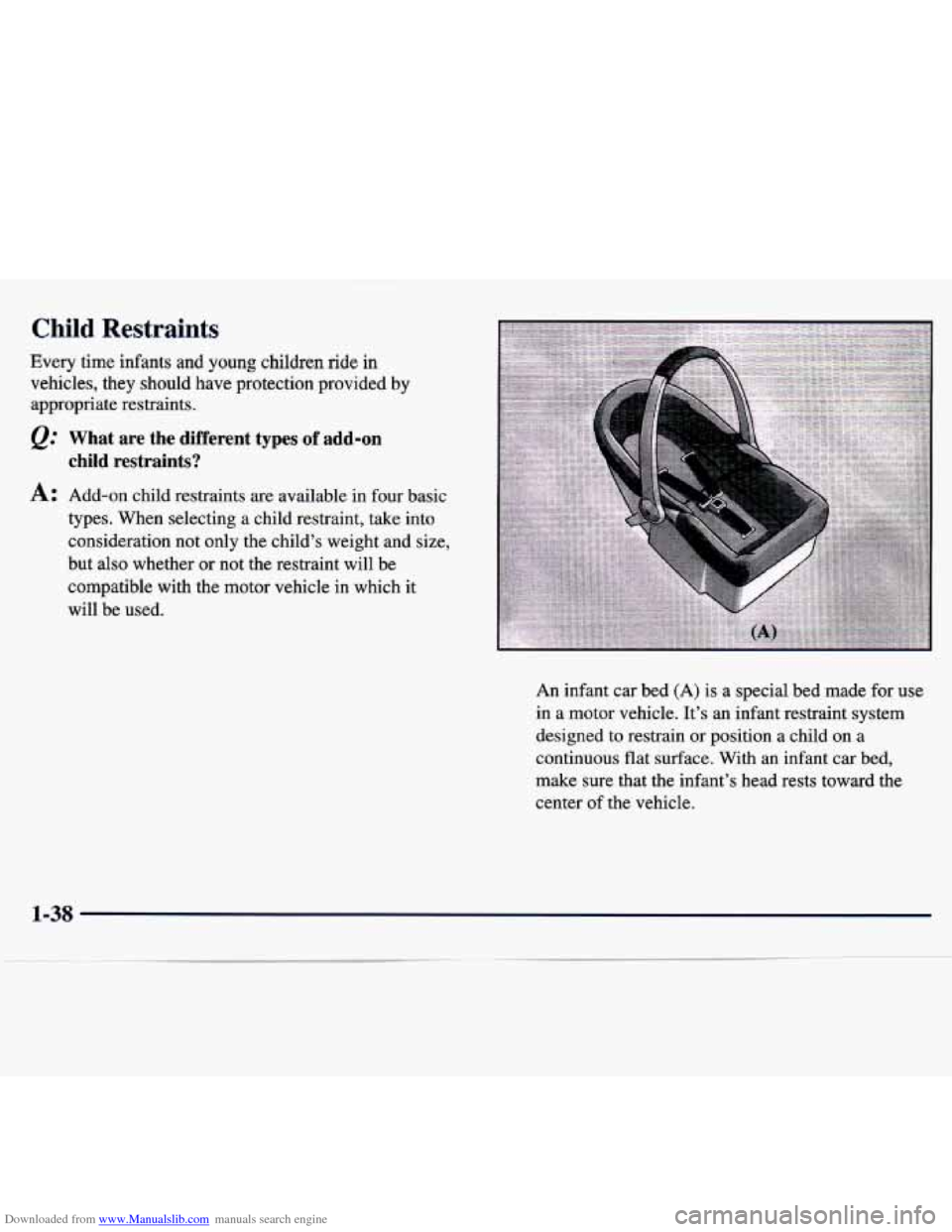
Downloaded from www.Manualslib.com manuals search engine Child Restraints
Every time infants and young children ride in
vehicles, they should have protection provided by
appropriate restraints.
@ What are the different types of add-on
A: Add-on child restraints are available in four basic
types. When selecting a child restraint, take into consideration not only the child’s weight and size,
but also whether or not the restraint will be
compatible with the motor vehicle in which it
will be used.
ghild restraints?
An infant car bed (A) is a special bed made for use
in a motor vehicle. It’s an infant restraint system
designed to restrain or position a child on
a
continuous flat surface. With an infant car bed,
make sure that the infant’s head rests toward the
center
of the vehicle.
1-38
Page 56 of 386

Downloaded from www.Manualslib.com manuals search engine Accident statistics show that children are safer if they
are restrained
in the rear seat. But they need to use the
safety belts properly.
Children who aren’t buckled up can be thrown out
in
a crash.
0 Children who aren’t buckled up can strike other
people who are.
I
/!1 CAUTION:
I Ne!!! do this.
Here two children are wearing the same belt. The
belt can’t properly spread the impact forces.
In a
crash, the two children can be crushed together
and seriously injured.
A belt must be used by
only one person at
a time.
@’ What if a child is wearing a lap-shoulder belt,
but the child
is so small that the shoulder belt is
very close to the child’s face or neck?
A: Move the child toward the center of the vehicle, but
be sure that the shoulder belt still is
on the child’s
shoulder,
so that in a crash the child’s upper body
would have the restraint that belts provide.
1-49
Page 63 of 386
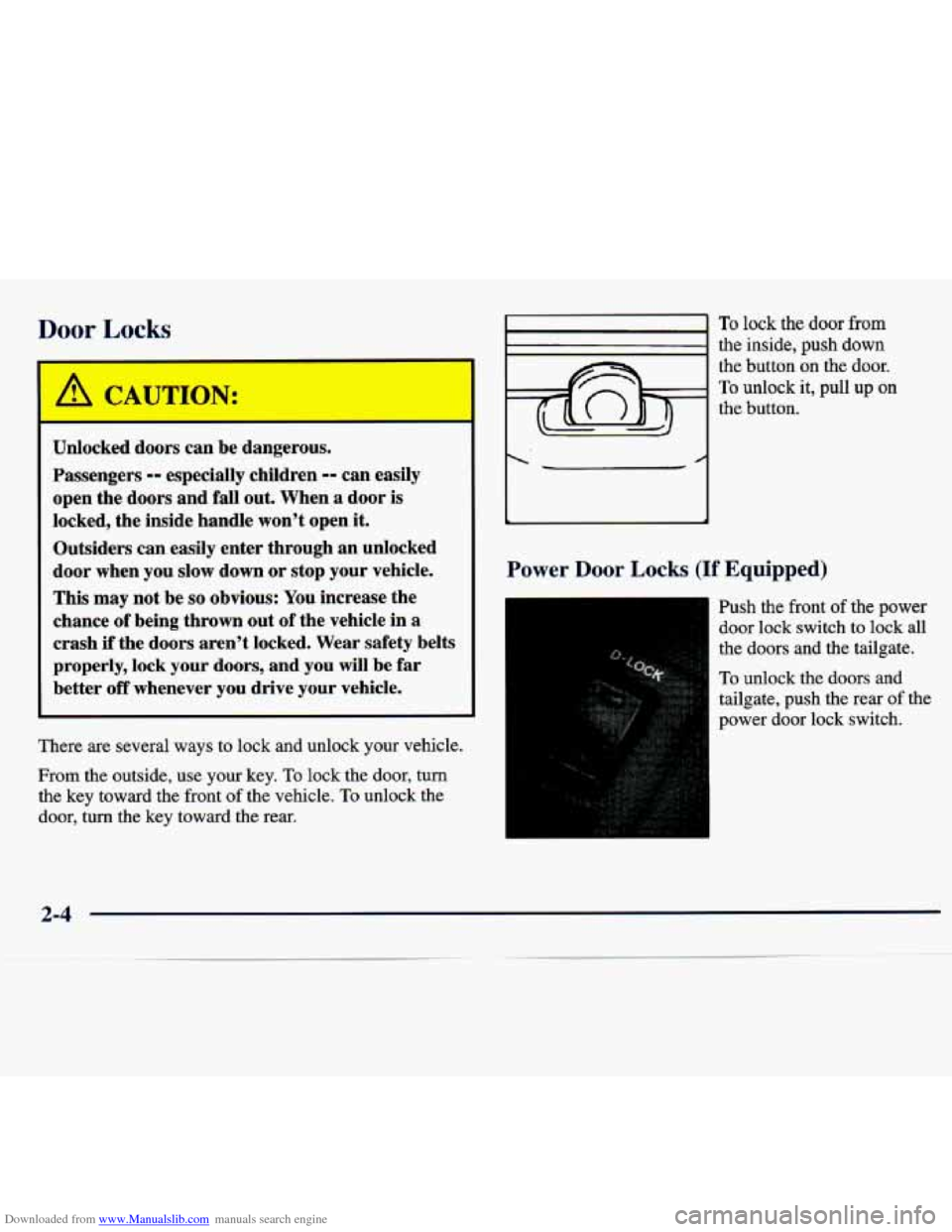
Downloaded from www.Manualslib.com manuals search engine Door Locks
Unlocked doors can be dangerous.
Passengers
-- especially children -- can easily
open the doors and fall out. When
a door is
locked, the inside handle won’t open it.
Outsiders can easily enter through an unlocked
door when you slow down or stop your vehicle.
This may not be
so obvious: You increase the
chance of being thrown out of the vehicle in
a
crash if the doors aren’t locked. Wear safety belts
properly, lock your doors, and you will be far
better
off whenever you drive your vehicle.
There are several
ways to lock and unlock your vehicle.
From the outside, use your key.
To lock the door, turn
the key toward the front of the vehicle.
To unlock the
door, turn the key toward the rear.
1
To lock the door from
the inside, push down
the button on the door.
To unlock it, pull up on
the button.
Power Door Locks (If Equipped)
Push the front of the power
door lock switch to lock all
the doors and the tailgate.
To unlock the doors and
tailgate, push the rear of the
power door lock switch.
2-4
Page 66 of 386
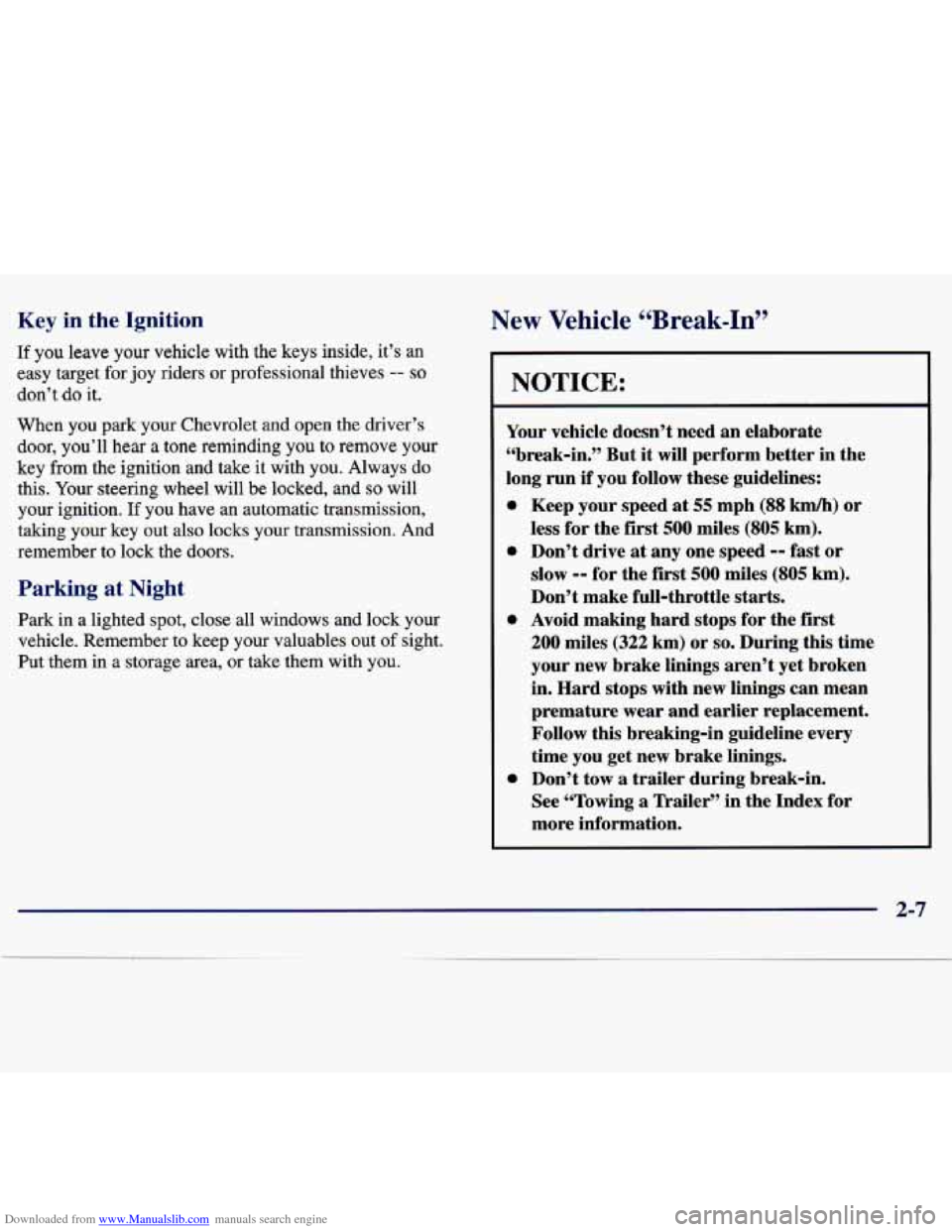
Downloaded from www.Manualslib.com manuals search engine Key in the Ignition
If you leave your vehicle with the keys inside, it’s an
easy target
for joy riders or professional thieves -- so
don’t do it.
When you park your Chevrolet and open the driver’s
door, you’ll hear a tone reminding you to remove your
key
from the ignition and take it with you. Always do
this. Your steering wheel will be locked, and so will
your ignition.
If you have an automatic transmission,
taking your key out also locks your transmission. And
remember
to lock the doors.
Parking at Night
Park in a lighted spot, close all windows and lock your
vehicle. Remember to keep your valuables out
of sight.
Put them in a storage area, or take them with
you.
New Vehicle ccBreak-InSS
NOTICE:
Your vehicle doesn’t need an elaborate
“break-in.)’ But
it will perform better in the
long run
if you follow these guidelines:
0
0
0
0
Keep your speed at 55 mph (88 kmh) or
less for the first 500 miles (805 km).
Don’t drive
at any one speed -- fast or
slow -- for the first 500 miles (805 km).
Don’t make full-throttle starts.
Avoid making hard stops for the
first
200 miles (322 km) or so. During this time
your new brake linings aren’t yet broken
in. Hard stops with new linings can mean
premature wear and earlier replacement.
Follow this breaking-in guideline every
time you get new brake linings.
Don’t tow
a trailer during break-in.
See “Towing
a Trailer” in the Index for
more information.
2-7
Page 67 of 386
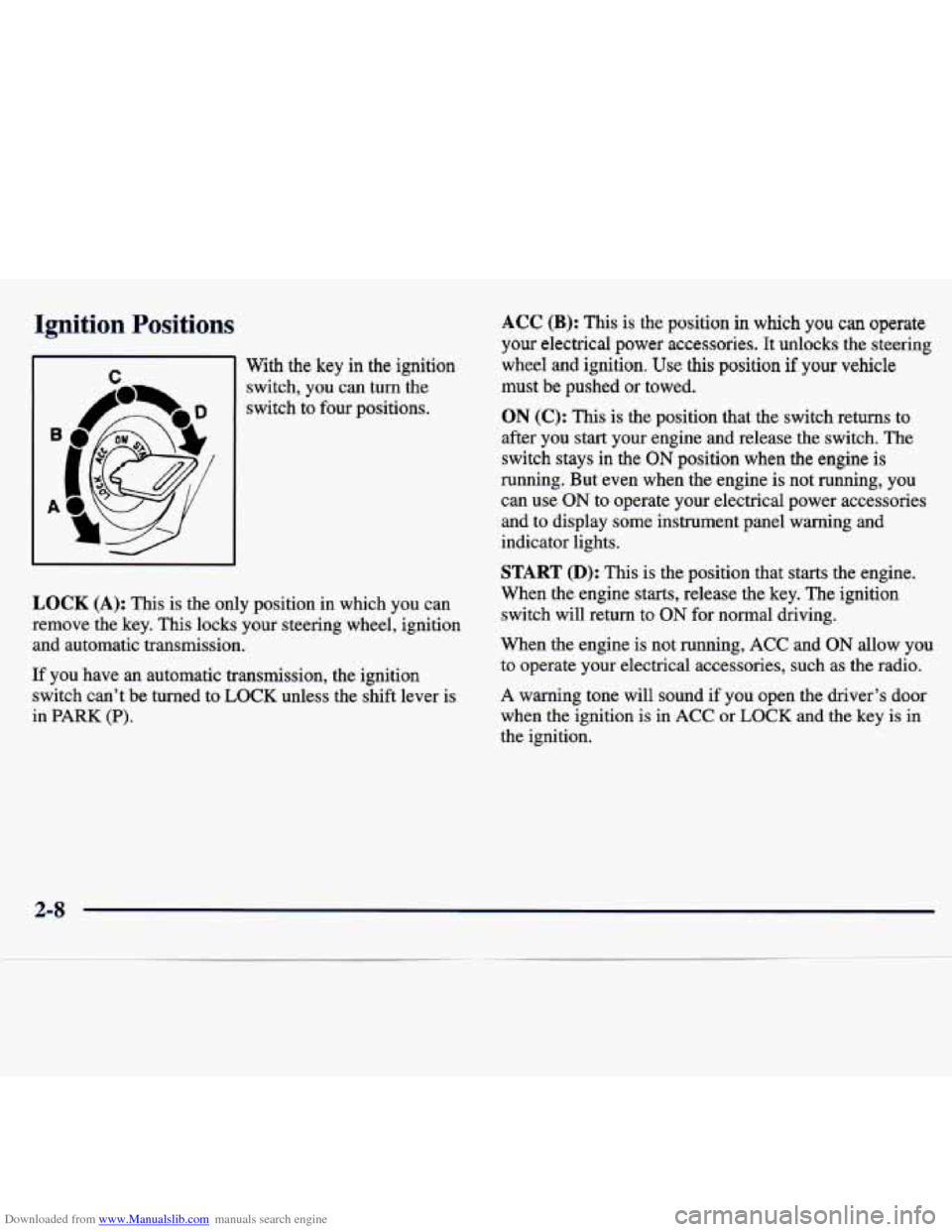
Downloaded from www.Manualslib.com manuals search engine Ignition Positions
m I With the key in the ignition
rr
4 I
switch, you can turn the
switch to four positions.
LOCK (A): This is the only position in which you can
remove the key. This locks your steering wheel, ignition and automatic transmission.
If you have
an automatic transmission, the ignition
switch can’t be turned to
LOCK unless the shift lever is
in
PARK (P).
ACC (B): This is the position in which you can operate
your electrical power accessories. It unlocks the steering
wheel and ignition. Use this position
if your vehicle
must be pushed or towed.
ON (C): This is the position that the switch returns to
after you start your engine and release the switch. The
switch stays in the
ON position when the engine is
running. But even when
the engine is not running, you
can use
ON to operate your electrical power accessories
and
to display some instrument panel warning and
indicator lights.
START (D): This is the position that starts the engine.
When the engine starts, release the key. The ignition
switch will return to
ON for normal driving.
When the engine is not running,
ACC and ON allow you
to operate your electrical accessories, such as the radio.
A warning tone will sound if you open the driver’s door
when the ignition is in
ACC or LOCK and the key is in
the ignition.
2-8